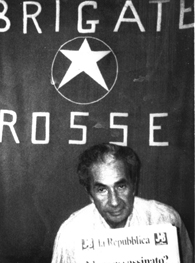On March 16, 1978, former Italian Prime Minister Aldo Moro was kidnapped by a left-wing extremist group; he was killed 55 days later when the terrorists’ demands were not met. Many in Italy believe that domestic or international government forces were complicit in the murder of Moro, who was due to sign a controversial agreement with the Communist Party on the day of his kidnapping.
Moro Kidnapped Before Compromise
Two-time former Prime Minister Aldo Moro, leader of the Christian Democratic Party, had negotiated an agreement to form a coalition government with the Italian Communist Party (PCI). Known as the Historic Compromise, it alarmed both right wing parties and the extreme left, including the Red Brigades, a Marxist-Leninist paramilitary group.
“The Red Brigades completely opposed this idea, as it interfered with the declared aim of spearheading an armed Marxist revolution in Italy, led by a ‘revolutionary proletariat,’” explains The Florentine.
On the morning on March 16, as Moro was en route to the House of Representatives to enact the compromise, a dozen members of Red Brigades launched an assault on his car. The extremists shot and killed five of Moro’s bodyguards and abducted him, taking him to a safe house.
The Red Brigades demanded the release of 13 leftist prisoners in exchange for Moro. Throughout his captivity, Moro was allowed to send letters to political allies and family members, in which he pleaded with the Italian government cooperate with the terrorists.
In one letter, Moro writes to Italian Interior Minister Francesco Cossiga: “Weigh your actions carefully in order to avoid further evil…In the given circumstances, besides humanitarian reasons, what becomes apparent is the reason of state. Most of all this reason of state means that in my present condition I find myself under full and uncontrolled domination. There is the risk that I will be induced to talk in a manner that could be dangerous…May God enlighten you for the best.”
Despite pleas from his friends, family and Pope Paul VI, the Italian government, which had negotiated with the Red Brigades in previous situations, refused to negotiate for Moro. On May 9, Moro’s body was found in the trunk of a car, parked symbolically between the headquarters of the Christian Democrats and the Communist Party.
Sources in this Story
- The Florentine: Aldo Moro
- Time: The Moro Tragedy Goes On
- Time: A Letter from Aldo Moro
- History.com: Aldo Moro found dead
- The Guardian: Sporchi trucchi
- The Guardian: Moro’s ghost haunts political life
- Robertobartali.it: Brigate Rosse and Moro Kidnapping: secrets and lies
- The Independent: The riddle of Aldo Moro: was Italy’s establishment happy to see him die?
- The Daily Telegraph: US envoy admits role in Aldo Moro killing
- The New Criterion: Mythmaking & the Aldo Moro case
- The BBC: Italy’s history of terror
- University of South Florida Scholar Commons/Journal of Strategic Security: Political Terrorism: An Historical Case Study of the Italian Red Brigades
Conspiracy Theories Surrounding Moro’s Murder
There are many theories that the Italian government or foreign governments were involved in Moro’s kidnapping, or that they were willing to let Moro be killed for their own political gain.
At issue is the Historic Compromise, which never went through due to the kidnapping. Italy would have become the first post-war Western European country to include communists in the majority government.
There were many significant opponents to the compromise: right-wing and anti-communist politicians, along with some Christian Democrats, did not want to see the Communists given power. Both the United States and Soviet Union opposed the compromise, believing that it would destabilize East-West relations. The United States and NATO were concerned that the deal might threaten NATO’s position in Italy.
A 1978 article by journalist Mino Pecorelli, who was murdered the following year, said that the kidnapping had “the hallmark of a lucid superpower.” Pecorelli suggested that the Gladio, a covert anti-communist network in NATO, aided the Red Brigades in the kidnapping.
Proponents of this theory point to the near-perfect execution of the kidnapping as evidence that the kidnappers were aided by elite forces. In particular, the fact that the kidnappers were able to kill the five bodyguards without harming Moro suggests that a professional shooter was involved.
There are also many people who believe that, even if the Red Brigades carried out the kidnapping without outside help, there were governmental figures who wanted Moro to be killed and obstructed efforts to save him.
Italian authorities launched a nationwide manhunt for Moro, but ignored key leads that would have led them to the kidnappers. Furthermore, for a country known for being willing to negotiate with terrorists, it was unusual for the government to adopt a hardline stance.
Steve Pieczenik, a hostage negotiator in the State Department, claimed in 2008 that Moro was “‘sacrificed’ for the ‘stability’ of Italy.” According to his book, “We Killed Aldo Moro,” the United States and Italian governments instructed Pieczenik to write and deliver a false statement attributed to the Red Brigades, announcing Moro’s death. Pieczenik said the statement was presented as a means of communicating to the Red Brigades that the Italian government already considered Moro dead, thereby removing the authority they leveraged through his captivity.
Richard Drake, author of “The Aldo Moro Case,” rejects the conspiracy theories that have emerged surrounding Moro’s murder. He argues that the killing more aptly represents the threats of a country captivated by Marxist-Leninist ideology: “For all those under the beguiling spell of the revolutionary mystique, the prescriptions of Marx and Lenin transformed the most bestial acts of inhumanity into thrilling deeds on behalf of the proletariat. The Moro kidnapping was just such an act.”
Related Events
- Red Brigades Kidnapping of General Dozier
- Iran Hostage Crisis
- Lebanon Hostage Crisis
- Munich Massacre
Background: The Red Brigades
The Brigate Rosse, known as the Red Brigades, was created in 1970s by radical Marxist-Leninist students who wished to see the overthrow off the capitalist system. The most active of Italy’s paramilitary groups during the “Year of Lead,” the Red Brigades became famous for kidnapping prominent Italian officials and industrialists.
Following the murder of Moro, the Italian government cracked down on the Red Brigades and the extreme left. More than 10,000 leftist leaders were arrested in 1980, while many of the Red Brigades’ leaders “disavowed their political doctrine and turned their comrades into the police,” reports The Florentine.
Due to the crackdown, Red Brigades fissured around the mid-1980s, splitting off into The New Red Brigades/Communist Combatant Party and the Union of Combatant Communists. The New Brigades inherited the militancy of the original Red Brigades. The New Red Brigades claimed responsibility for the assassinations of labor minister advisor Massimo D’Antona in 1999, professor Marco Biagi in 2002 and a police officer in 2003.











